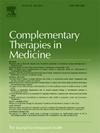聚焦体外冲击波治疗对肌筋膜疼痛综合征患者肌肉及邻近组织僵硬和疼痛变化的疗效:一项随机对照试验研究。
IF 3.5
3区 医学
Q1 INTEGRATIVE & COMPLEMENTARY MEDICINE
引用次数: 0
摘要
背景:聚焦体外冲击波疗法(fESWT)最近被应用于慢性疼痛的治疗。然而,它在减轻办公室工作人员肌肉僵硬和疼痛方面的有效性尚未得到广泛研究。本研究旨在探讨fESWT和假fESWT在缓解肌肉僵硬、疼痛和功能障碍方面的有效性。方法:64名患有上斜方肌筋膜疼痛综合征的上班族(平均年龄31.4±9.5岁)随机平均分配接受fESWT或假fESWT。干预每周一次,持续4周,频率为4Hz,总能量为0.10.232 mJ/mm²。在基线、治疗后立即、两周和四周记录测量结果,评估剪切模量(组织刚度)、视觉模拟量表(VAS)和颈部残疾指数(NDI)。结果:结果显示,4周后,触发点剪切模量显著急性降低(6.1 kPa, p=0.009),下腱膜肌肉僵硬度延迟降低(5.3 kPa, p=0.004)。此外,fESWT后所有时间点的VAS评分均下降(结论:fESWT可有效减轻患者的肌肉疼痛、僵硬和功能残疾)。然而,假feswt对VAS和功能的潜在心理影响应予以考虑。为了更好地确定fESWT的疗效,需要进一步的研究来确定fESWT的最佳治疗时间和强度。本文章由计算机程序翻译,如有差异,请以英文原文为准。
Therapeutic effect of focused-extracorporeal shockwave therapy on muscular and adjacent tissue stiffness and pain changes in myofascial pain syndrome: A randomized controlled trial study
Background
Focused-extracorporeal shockwave therapy (fESWT) has recently been applied in the management of chronic pain. However, its effectiveness in reducing muscular stiffness and pain among office workers has not been extensively studied. This study aimed to investigate the effectiveness of fESWT and sham-fESWT in alleviating muscular stiffness, pain, and functional disability.
Methods
Sixty-four office workers (mean age 31.4 ± 9.5 years) with myofascial pain syndrome of the upper trapezius were randomly and equally assigned to receive either the fESWT or sham-fESWT. The interventions were administered once a week for 4 weeks, with 4 Hz frequency and a total energy of 0.1![]() 0.232 mJ/mm². Measurements were recorded at baseline, immediately after treatment, at two weeks, and at four weeks, assessing shear modulus (tissue stiffness), visual analogue scale (VAS), and the neck disability index (NDI).
0.232 mJ/mm². Measurements were recorded at baseline, immediately after treatment, at two weeks, and at four weeks, assessing shear modulus (tissue stiffness), visual analogue scale (VAS), and the neck disability index (NDI).
Results
The result demonstrated a significant acute decrease in shear modulus at the trigger point (![]() 6.1 kPa, p = 0.009) and a delayed reduction in muscle stiffness of the lower aponeurosis (
6.1 kPa, p = 0.009) and a delayed reduction in muscle stiffness of the lower aponeurosis (![]() 5.3 kPa, p = 0.004) following 4 weeks. Additionally, VAS scores decreased at all time points following fESWT (p < 0.05), while the sham-fESWT group also demonstrated reductions during the final two weeks. NDI showed a decrease in both groups after four sessions (p < 0.05), with no group effect.
5.3 kPa, p = 0.004) following 4 weeks. Additionally, VAS scores decreased at all time points following fESWT (p < 0.05), while the sham-fESWT group also demonstrated reductions during the final two weeks. NDI showed a decrease in both groups after four sessions (p < 0.05), with no group effect.
Conclusion
fESWT was effective in reducing muscular pain, stiffness, and functional disability in patients. However, the potential psychological effects of sham-fESWT on VAS and function should be considered. Further research is necessary to determine the optimal treatment sessions and intensity of fESWT to better establish its efficacy.
求助全文
通过发布文献求助,成功后即可免费获取论文全文。
去求助
来源期刊

Complementary therapies in medicine
医学-全科医学与补充医学
CiteScore
8.60
自引率
2.80%
发文量
101
审稿时长
112 days
期刊介绍:
Complementary Therapies in Medicine is an international, peer-reviewed journal that has considerable appeal to anyone who seeks objective and critical information on complementary therapies or who wishes to deepen their understanding of these approaches. It will be of particular interest to healthcare practitioners including family practitioners, complementary therapists, nurses, and physiotherapists; to academics including social scientists and CAM researchers; to healthcare managers; and to patients. Complementary Therapies in Medicine aims to publish valid, relevant and rigorous research and serious discussion articles with the main purpose of improving healthcare.
 求助内容:
求助内容: 应助结果提醒方式:
应助结果提醒方式:


